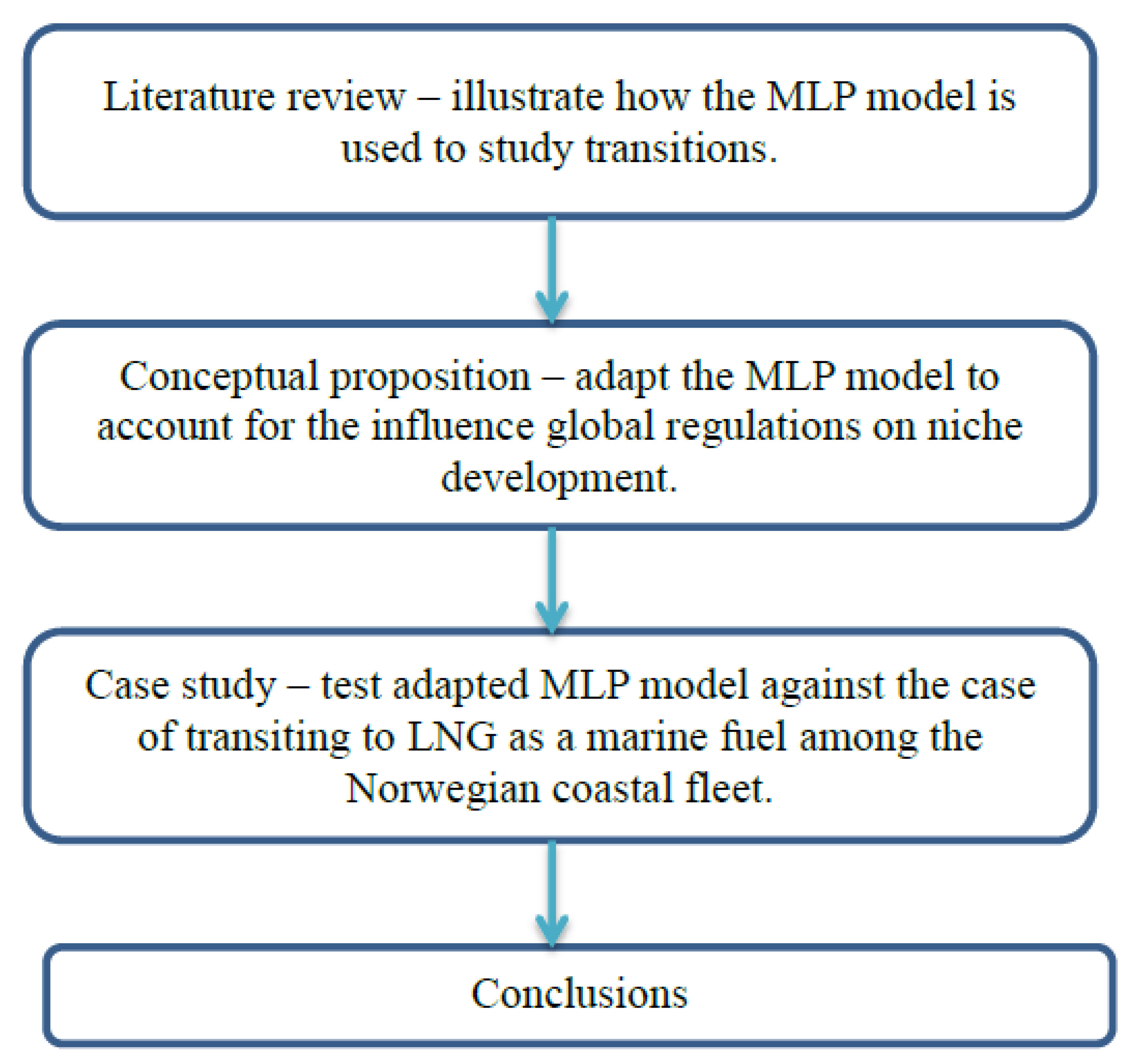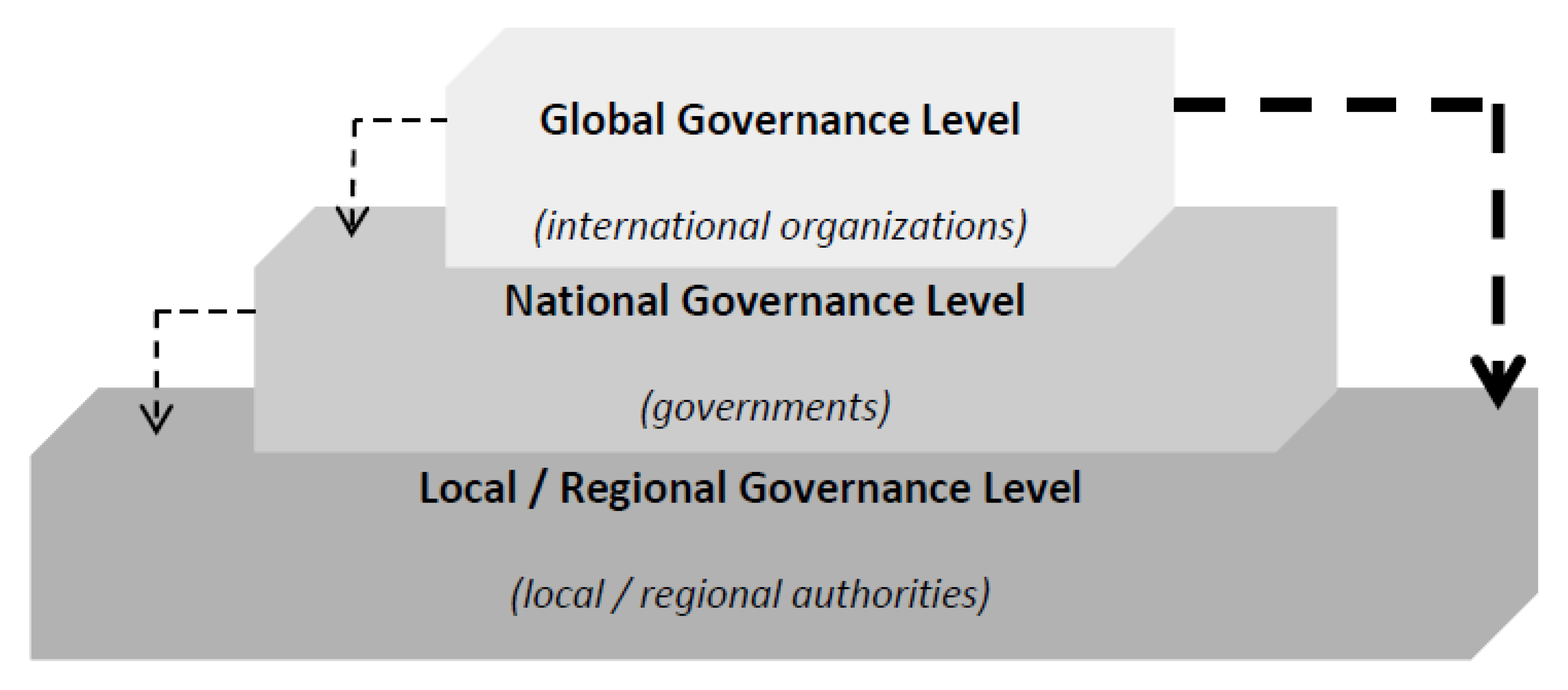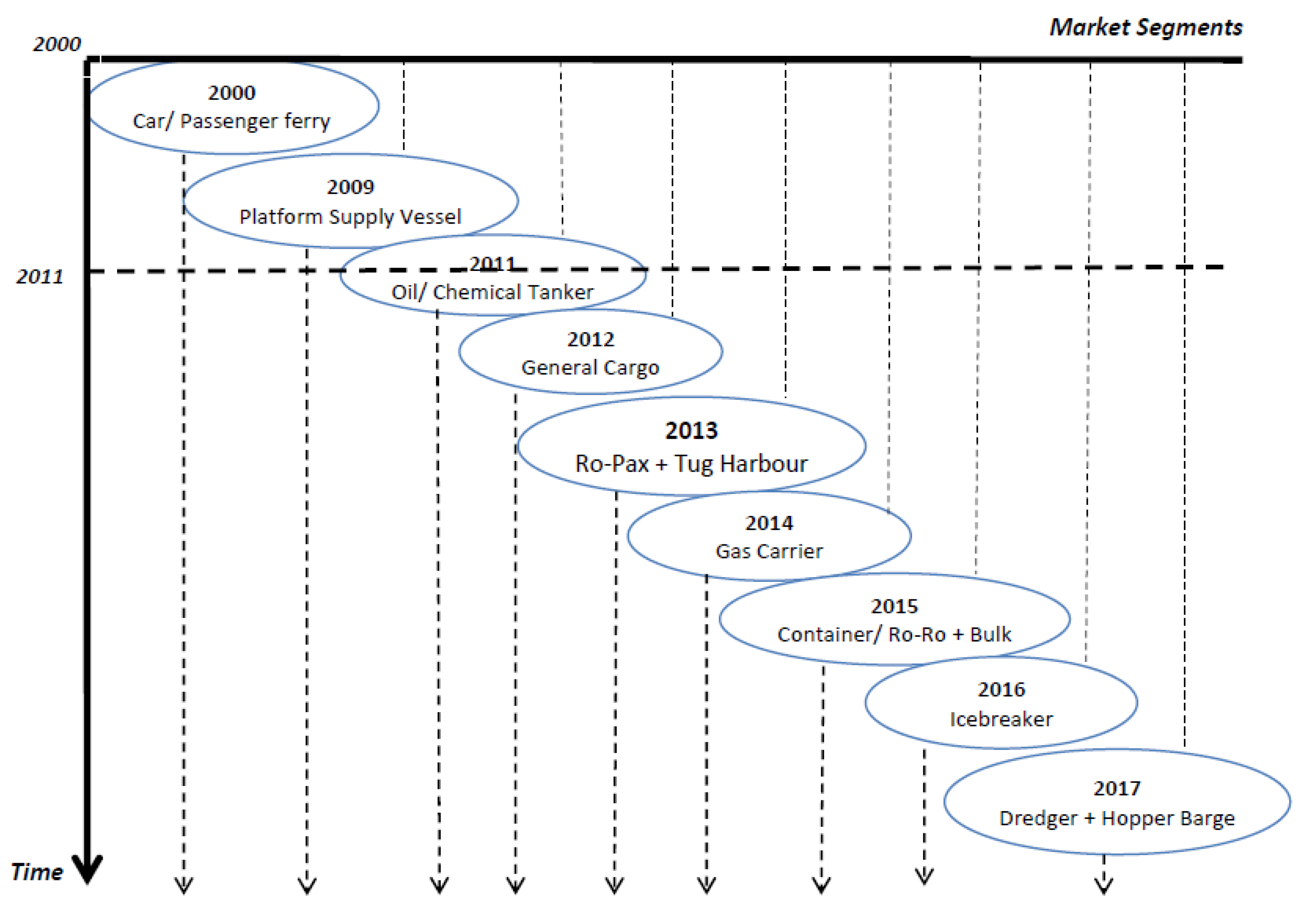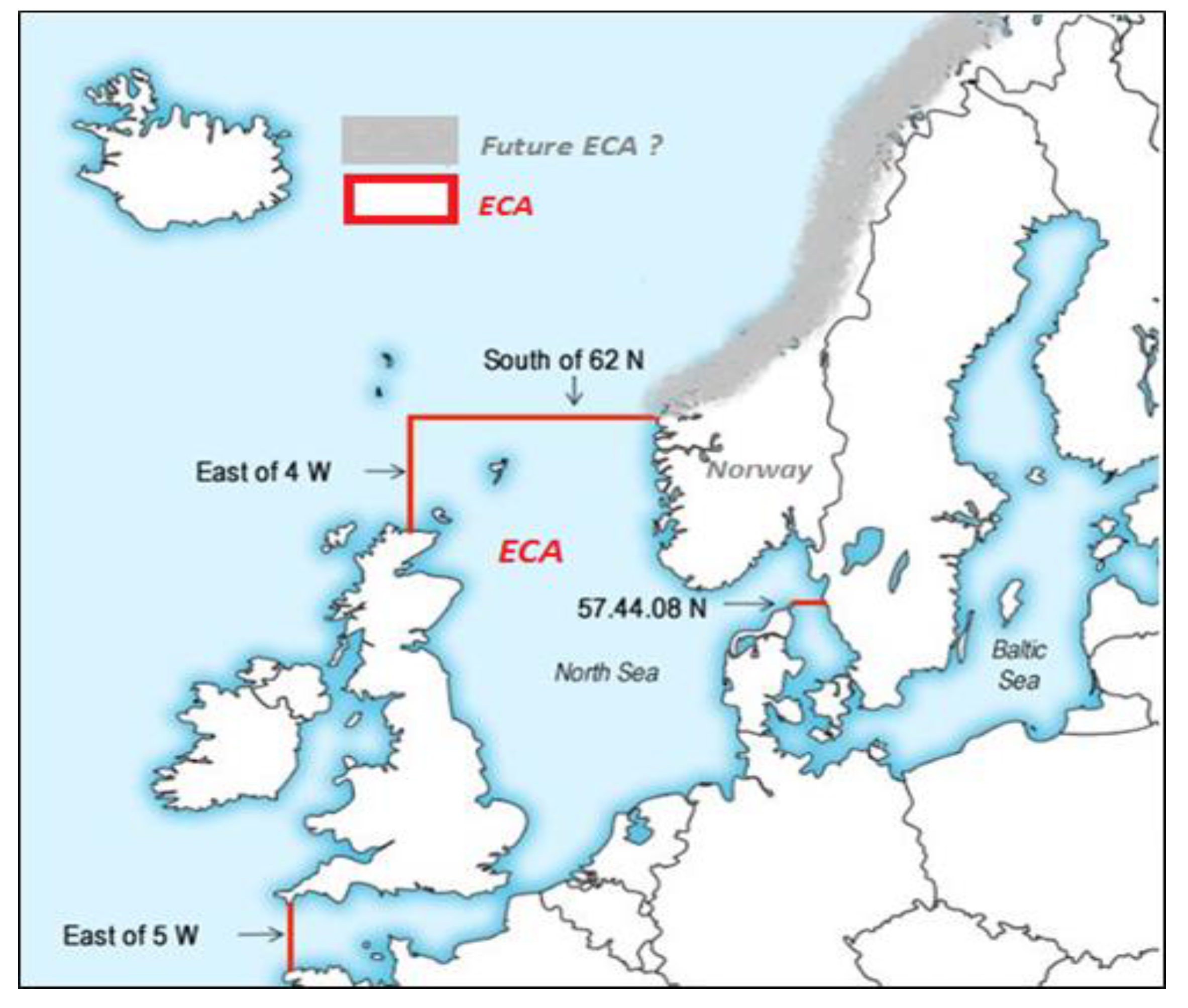Promoting LNG as A Marine Fuel in Norway: Reflections on the Role of Global Regulations on Local Transition Niches
Abstract
:1. Introduction
2. Literature Review
2.1. Multi-Level Perspective: A Conceptual Tool for Understanding Sustainability Transitions
2.2. Multi-Governance Level: Towards a Top-Down Approach in Considering External Regulation Systems
2.3. Niche-Based Analysis: A Global–Local Perspective on the Development of Transition Niches
3. Case Study: Sustainable Transition of LNG as Marine Fuel in Norwegian Shipping
3.1. LNG as a New Marine Fuel in Norway: State of Affairs 2001–2018
3.2. Niche Accumulation and Hybridisation Strategies: Ferry Segment and Dual-fuel Utilization
3.3. Global–Local Niche Analysis: From Emission Control Areas (ECAs) to Local Niche Segments
4. Conclusions
Author Contributions
Funding
Conflicts of Interest
References
- Geels, F.W. Technological transitions as evolutionary reconfiguration processes: A multi-level perspective and a case-study. Res. Policy 2002, 31, 1257–1274. [Google Scholar] [CrossRef] [Green Version]
- Geels, F.W. From sectoral systems of innovation to socio-technical systems. Res. Policy 2004, 33, 897–920. [Google Scholar] [CrossRef]
- Geels, I.F.W. The dynamics of transitions in socio-technical systems: A multi-level analysis of the transition pathway from horse-drawn carriages to automobiles (1860–1930). Technol. Anal. Strat. Manag. 2005, 17, 445–476. [Google Scholar] [CrossRef]
- Geels, F.W. A socio-technical analysis of low-carbon transitions: Introducing the multi-level perspective into transport studies. J. Transp. Geogr. 2012, 24, 471–482. [Google Scholar] [CrossRef]
- Geels, F.W. Transformations of Large Technical Systems. Sci. Technol. Hum. Values 2007, 32, 123–149. [Google Scholar] [CrossRef]
- Smith, A.; Stirling, A.; Berkhout, F. The governance of sustainable socio-technical transitions. Res. Policy 2005, 34, 1491–1510. [Google Scholar] [CrossRef]
- Genus, A.; Coles, A.-M. Rethinking the multi-level perspective of technological transitions. Res. Policy 2008, 37, 1436–1445. [Google Scholar] [CrossRef]
- Markard, J.; Raven, R.R.; Truffer, B. Sustainability transitions: An emerging field of research and its prospects. Res. Policy 2012, 41, 955–967. [Google Scholar] [CrossRef]
- Geels, F.W.; Hekkert, M.P.; Jacobsson, S. The dynamics of sustainable innovation journeys. Technol. Anal. Strat. Manag. 2008, 20, 521–536. [Google Scholar] [CrossRef] [Green Version]
- Weber, M. Transforming Large Socio-technical Systems towards Sustainability: On the Role of Users and Future Visions for the Uptake of City Logistics and Combined Heat and Power Generation. Innov. Eur. J. Soc. Sci. Res. 2003, 16, 155–175. [Google Scholar] [CrossRef]
- Verbong, G.; Geels, F. The ongoing energy transition: Lessons from a socio-technical, multi-level analysis of the Dutch electricity system (1960–2004). Energy Policy 2007, 35, 1025–1037. [Google Scholar] [CrossRef]
- Rip, A.; Kemp, R.; Kemp, R. Technological Change. Hum. Choice Clim. Chang. 1998, 2, 327–399. [Google Scholar]
- Rotmans, J.; Kemp, R.; Van Asselt, M. More evolution than revolution: Transition management in public policy. Foresight 2001, 3, 15–31. [Google Scholar] [CrossRef]
- Coenen, L.; Benneworth, P.; Truffer, B. Toward a spatial perspective on sustainability transitions. Res. Policy 2012, 41, 968–979. [Google Scholar] [CrossRef]
- Schot, J.; Geels, F.W. Strategic niche management and sustainable innovation journeys: Theory, findings, research agenda, and policy. Technol. Anal. Strat. Manag. 2008, 20, 537–554. [Google Scholar] [CrossRef]
- Nelson, R.R.; Winter, S.G. An Evolutionary Theory of Economic Change; Harvard University Press: Boston, MA, USA, 1982. [Google Scholar]
- Cozzens, S.E.; Bijker, W.E.; Hughes, T.P.; Pinch, T. The Social Construction of Technological Systems: New Directions in the Sociology and History of Technology. Technol. Cult. 1989, 30, 705. [Google Scholar] [CrossRef] [Green Version]
- Smith, A.; Voß, J.-P.; Grin, J. Innovation studies and sustainability transitions: The allure of the multi-level perspective and its challenges. Res. Policy 2010, 39, 435–448. [Google Scholar] [CrossRef]
- Raven, R.R. Niche accumulation and hybridisation strategies in transition processes towards a sustainable energy system: An assessment of differences and pitfalls. Energy Policy 2007, 35, 2390–2400. [Google Scholar] [CrossRef]
- Kemp, R.; Rip, A.; Schot, J. Constructing transition paths through the management of niches. In Path Dependence and Creation; Lawrence Erlbaum: Mahwah, NJ, USA, 2001; pp. 269–299. [Google Scholar]
- Kemp, R.; Schot, J.J.; Hoogma, R. Regime shifts to sustainability through processes of niche formation: The approach of strategic niche management. Technol. Anal. Strat. Manag. 1998, 10, 175–198. [Google Scholar] [CrossRef]
- Avelino, F.; Wittmayer, J.M. Shifting Power Relations in Sustainability Transitions: A Multi-actor Perspective. J. Environ. Policy Plan. 2016, 18, 628–649. [Google Scholar] [CrossRef]
- Farla, J.; Markard, J.; Raven, R.R.; Coenen, L. Sustainability transitions in the making: A closer look at actors, strategies and resources. Technol. Forecast. Soc. Chang. 2012, 79, 991–998. [Google Scholar] [CrossRef] [Green Version]
- Kemp, R.; Loorbach, D.; Rotmans, J. Transition management as a model for managing processes of co-evolution towards sustainable development. Int. J. Sustain. Dev. World Ecol. 2007, 14, 78–91. [Google Scholar] [CrossRef] [Green Version]
- Grin, J. Understanding transitions from a governance perspective, Part III. In Transitions to Sustainable Development, New Directions in the Study of Long Term Transformative Change; Grin, J., Rotmans, J., Schot, J., Eds.; Routledge: New York, NY, USA, 2010. [Google Scholar]
- Shove, E.; Walker, G. Caution! Transitions Ahead: Politics, Practice, and Sustainable Transition Management. Environ. Plan. A Econ. Space 2007, 39, 763–770. [Google Scholar] [CrossRef] [Green Version]
- Meadowcroft, J. Engaging with the politics of sustainability transitions. Environ. Innov. Soc. Transitions 2011, 1, 70–75. [Google Scholar] [CrossRef]
- Kern, F. The discursive politics of governing transitions towards sustainability: The UK Carbon Trust. Int. J. Sustain. Dev. 2012, 15, 90. [Google Scholar] [CrossRef]
- Fischer, L.-B.; Newig, J. Importance of Actors and Agency in Sustainability Transitions: A Systematic Exploration of the Literature. Sustainability 2016, 8, 476. [Google Scholar] [CrossRef] [Green Version]
- Hooghe, L.; Marks, G. Unraveling the central state, but how? Types of multi-level governance. Am. Political Sci. Rev. 2003, 97, 233–243. [Google Scholar]
- Quitzau, M.-B.; Hoffmann, B.; Elle, M. Local niche planning and its strategic implications for implementation of energy-efficient technology. Technol. Forecast. Soc. Chang. 2012, 79, 1049–1058. [Google Scholar] [CrossRef]
- Babaei, M.; Asgarian, F.; Jamali, M.-B.; Rasti-Barzoki, M.; Piran, J. A game theoretic approach for pricing petroleum and determining investors’ production volume with the consideration of government and intermediate producers. Sustain. Energy Technol. Assessments 2020, 42, 100825. [Google Scholar] [CrossRef]
- Ray, A.; De, A.; Mondal, S.; Wang, J. Selection of best buyback strategy for original equipment manufacturer and independent remanufacturer–game theoretic approach. Int. J. Prod. Res. 2020, 1–30. [Google Scholar] [CrossRef]
- Goswami, M.; Daultani, Y.; De, A. Decision Modeling and Analysis in New Product Development Considering Supply Chain Uncertainties: A Multi-Functional Expert Based Approach. Expert Syst. Appl. 2020, 114016. [Google Scholar] [CrossRef]
- Raven, R.; Schot, J.; Berkhout, F. Space and scale in socio-technical transitions. Environ. Innov. Soc. Transit. 2012, 4, 63–78. [Google Scholar] [CrossRef]
- Schot, J.; Geels, F.W. Niches in evolutionary theories of technical change. J. Evol. Econ. 2007, 17, 605–622. [Google Scholar] [CrossRef] [Green Version]
- Yin, R.K. Case Study Research and Applications: Design and Methods; Sage publications: Newbury Park, CA, USA, 2009. [Google Scholar]
- OECD. Fuelling Maritime Shipping with Liquefied Natural Gas: The Case of Japon I.T.F.P.P. 49; Organisation for Economic Co-operation and Development: Paris, France, 2018. [Google Scholar]
- Stenersen, D.; Thonstad, O. GHG and NOx Emissions from Gas Fuelled Engines. Mapping, Verification, Reduction Technologies; SINTEF Ocean AS: Trondheim, Norway, 2017. [Google Scholar]
- Lindstad, E.; Eskeland, G.S.; Rialland, A.; Valland, A. Decarbonizing Maritime Transport: The Importance of Engine Technology and Regulations for LNG to Serve as a Transition Fuel. Sustainability 2020, 12, 8793. [Google Scholar] [CrossRef]
- Thinkstep. Life Cycle GHG Emission Study on the Use of LNG as Marine Fuel. 2019. Available online: https://www.thinkstep.com/content/life-cycle-ghg-emission-study-use-lng-marine-fuel-1 (accessed on 10 November 2020).
- Pavlenko, N. The Climate Implications of Using LNG as a Marine Fuel; Working Paper; International Council on Clean Transportation: Washington, DC, USA, 2020. [Google Scholar]
- Ushakov, S.; Stenersen, D.; Einang, P.M. Methane slip from gas fuelled ships: A comprehensive summary based on measurement data. J. Mar. Sci. Technol. 2019, 24, 1308–1325. [Google Scholar] [CrossRef]
- Lindstad, H.E.; Rialland, A. LNG and Cruise Ships, an Easy Way to Fulfil Regulations—Versus the Need for Reducing GHG Emissions. Sustainability 2020, 12, 2080. [Google Scholar] [CrossRef] [Green Version]
- OIES. LNG Supply Chains and the Development of LNG as a Shipping Fuel in Northern Europe; OIES: Oxford, UK, 2019; p. 30. [Google Scholar]
- Zhongying, W.; Sandholt, K. Thoughts on China’s energy transition outlook. Energy Transit. 2019, 3, 59–72. [Google Scholar] [CrossRef] [Green Version]
- Stopford, M. Maritime Economics; Routledge: New York, NY, USA, 2009. [Google Scholar]
- IMO. Studies of the Feasibility and Use of LNG as a Fuel for Shipping; International Marine Organization: London, UK, 2016; p. 284. [Google Scholar]
- IMO. Presentation of Air Pollution from Ships. 2019. Available online: http://www.imo.org/en/ourwork/environment/pollutionprevention/airpollution/pages/air-pollution.aspx (accessed on 15 October 2020).
- IMO. Air Pollution from Ships Cut, with Entry into Force of MARPOL Amendments 2019. Available online: http://www.imo.org/en/MediaCentre/PressBriefings/Pages/MARPOL-Annex-VI-EIF.aspx#.XOR0oFJKjIU (accessed on 21 October 2020).
- Čampara, L.; Hasanspahić, N.; Vujičić, S. Overview of MARPOL ANNEX VI regulations for prevention of air pollution from marine diesel engines. SHS Web Conf. 2018, 58. [Google Scholar] [CrossRef]
- International Maritime Organization. MARPOL Consolidated Edition 2017; IMO: London, UK, 2017. [Google Scholar]
- DNV-GL. In Focus-LNG as Ship Fuel: Latest Developments and Projects in the LNG Industry; DNV-GL: Oslo, Norway, 2015. [Google Scholar]
- Norwegian Ministry of Climate and Environment. Norwegian Policy to Mitigate Climate Changes and Reduce Emissions of Nitrogen Oxides (NOx)-Summary; Norwegian Ministry of Climate and Environment: Oslo, Norway, 2017. [Google Scholar]
- NOx-Fondet. About the NOx Fund 2018. Available online: https://www.nho.no/samarbeid/nox-fondet/the-nox-fund/articles/about-the-nox-fund/ (accessed on 15 November 2019).
- Norwegian Ministry of Climate and Environment. Norway’s Seventh National Communication: Under the Framework Convention on Climate Change; Norwegian Ministry of Climate and Environment: Oslo, Norway, 2018; p. 460. [Google Scholar]
- Wang, S.; Notteboom, T. LNG as a ship fuel: Perspectives and challenges. Global Issues 2013, 60, 15–17. [Google Scholar]
- Calderón, M.; Illing, D.; Veiga, J. Facilities for Bunkering of Liquefied Natural Gas in Ports. Transp. Res. Procedia 2016, 14, 2431–2440. [Google Scholar] [CrossRef] [Green Version]
- Aronietis, R.; Sys, C.; Van Hassel, E.; Vanelslander, T. Forecasting port-level demand for LNG as a ship fuel: The case of the port of Antwerp. J. Shipp. Trade 2016, 1, 2. [Google Scholar] [CrossRef] [Green Version]
- De, A.; Choudhary, A.; Türkay, M.; Tiwari, M.K. Bunkering policies for a fuel bunker management problem for liner shipping networks. Eur. J. Oper. Res. 2019. [Google Scholar] [CrossRef]
- De, A.; Wang, J.; Tiwari, M.K. Fuel Bunker Management Strategies Within Sustainable Container Shipping Operation Considering Disruption and Recovery Policies. IEEE Trans. Eng. Manag. 2019, 1–23. [Google Scholar] [CrossRef] [Green Version]
- Ghosh, S.; Lee, L.H.; Ng, S.H. Bunkering decisions for a shipping liner in an uncertain environment with service contract. Eur. J. Oper. Res. 2015, 244, 792–802. [Google Scholar] [CrossRef]
- Norwegian Ministry of Trade, Industry and Fisheries and Norwegian Ministry of Petroleum and Energy. New Growth, Proud History. The Norwegian Government’s Ocean Strategy; Norwegian Ministry of Trade, Industry and Fisheries and Norwegian Ministry of Petroleum and Energy: Oslo, Norway, 2015; p. 105. [Google Scholar]
- Wang, S.; Notteboom, T. The role of port authorities in the development of LNG bunkering facilities in North European ports. WMU J. Marit. Aff. 2015, 14, 61–92. [Google Scholar] [CrossRef] [Green Version]
- North European Oil Trade. LNG as a Ship Fuel in the Baltic Sea Region: Study for LNG Supply Chain; NEOT: Helsinki, Finland, 2015; p. 40. [Google Scholar]
- Rodrigues, A.P.R.D.S. The Training of Officers and Crew of LNG-Fuelled Vessels: A Case Study of Norway. Master’s Thesis, Chalmers University of Technology, Göteborg, Sweden, 2013. [Google Scholar]






| Type of Engine | Pure LNG | Percentage (%) | Dual Fuel | Percentage (%) |
|---|---|---|---|---|
| Type of Vessel | ||||
| Ferry | 16 | 53.3% | 8 | 25.8% |
| PSV | 2 | 6.6% | 17 | 54.8% |
| General Cargo | 5 | 16.6% | 0 | 0 |
| Tug | 2 | 6.6% | 3 | 9.6% |
| Oil/Chemical | 3 | 10% | 0 | 0 |
| Ro-Ro Pax | 2 | 6.6% | 0 | 0 |
| Other services | 0 | 0 | 3 | 9.6% |
| Total | 30 | 100% | 31 | 100% |
| Governance Levels | Institutions or Organizations | Projects, Programs or Laws | Year of Entry into Force | Rational and Goals |
|---|---|---|---|---|
| Global | I.M.O (International Maritime Organization) | MARPOL Annex IV | (1997) | Regulations aim to reduce harmful emissions from ships. |
| Emission control areas | (2000) | Controlled areas where (Nox) and (Sox) emission levels are limited. | ||
| Global on Local | Ports Authorities (International Maritime Organization) | International Code of Safety for Ships using gases and other low-flashpoint fuels (IGF Code) | (2015) | To provide an international standard for ships, other than vessels covered by the IGC Code, operating with gas or low-flashpoint liquids as fuel. |
| International Association of Ports and Harbours (IAPH) International Organisation Standardisation (ISO) | LNG Bunkering Standards | (2016) | Set of harmonized standards will ensure that key areas of the LNG bunkering process are aligned across ports carrying out LNG bunkering operations. | |
| National | N.M.C.E (Norwegian Ministry of Climate and Environment) | NOx Fund (I) | (2008) | All ships operating in Norway pay into the fund. Shipping companies can then apply for subsidy from the same fund to finance projects that would help to reduce Nox emissions from their ships. |
| NOx Fund (II) | (2018) | |||
| National on Regional | Municipalities (Norwegian Ministry of Petroleum and Energy) | ENOVA programs | (2001) | Developing an energy and climate plan is only one of several processes that are necessary for a municipality to achieve its targets for energy efficiency, renewable energy and reduction of greenhouse gas emissions. |
| National on Local | Ports Authorities (Norwegian Maritime Authorities) | Regulation concerning cargo ships with natural gas-fueled engine | (2002) | Regulations with mandatory requirements for training officers and crew of LNG-fueled vessels. |
| Regulation concerning the construction and operation of gas-fueled passenger ships | (2005) |
Publisher’s Note: MDPI stays neutral with regard to jurisdictional claims in published maps and institutional affiliations. |
© 2020 by the authors. Licensee MDPI, Basel, Switzerland. This article is an open access article distributed under the terms and conditions of the Creative Commons Attribution (CC BY) license (http://creativecommons.org/licenses/by/4.0/).
Share and Cite
Laribi, S.; Guy, E. Promoting LNG as A Marine Fuel in Norway: Reflections on the Role of Global Regulations on Local Transition Niches. Sustainability 2020, 12, 9476. https://doi.org/10.3390/su12229476
Laribi S, Guy E. Promoting LNG as A Marine Fuel in Norway: Reflections on the Role of Global Regulations on Local Transition Niches. Sustainability. 2020; 12(22):9476. https://doi.org/10.3390/su12229476
Chicago/Turabian StyleLaribi, Sofiane, and Emmanuel Guy. 2020. "Promoting LNG as A Marine Fuel in Norway: Reflections on the Role of Global Regulations on Local Transition Niches" Sustainability 12, no. 22: 9476. https://doi.org/10.3390/su12229476




